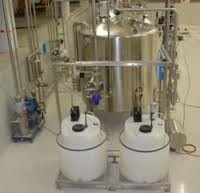Difference between revisions of "Cleaning In Place CIP Courses"
| Line 1: | Line 1: | ||
[[Category:Courses, Training]]{{Knoppen}} | [[Category:Courses, Training]]{{Knoppen}} | ||
Cleaning In Place CIP Course is a method of cleaning the interior surfaces of pipes, vessels, process equipment, filters and associated fittings, without disassembly. | [[File:Cip.jpg|thumb|right|Cleaning In Place]] | ||
'''Cleaning In Place CIP Course''' is a method of cleaning the interior surfaces of pipes, vessels, process equipment, filters and associated fittings, without disassembly.The principles of CIP can be applied to any industry and plant where hygiene is critical; and the process is usually an integral part of any automated plant. Increasing health and safety legislation is set to make CIP more common, which is a good thing because a shiny surface on the outside of plant is no guarantee of cleanliness on the inside. | |||
CIP is principally concerned with soil removal: soil being anything that should not be present in a clean vessel. Soil can cause tainting and can often be smelt. It can be visible or invisible in the form of bacteria, such as e coli, or yeast spores. The time needed to remove soil is at least 15 minutes using a suitable chemical at temperatures above 50 degrees C, but no greater than 75 degrees C because there is no advantage to be gained above this temperature. | |||
Latest revision as of 09:42, 15 May 2013
Cleaning In Place CIP Course is a method of cleaning the interior surfaces of pipes, vessels, process equipment, filters and associated fittings, without disassembly.The principles of CIP can be applied to any industry and plant where hygiene is critical; and the process is usually an integral part of any automated plant. Increasing health and safety legislation is set to make CIP more common, which is a good thing because a shiny surface on the outside of plant is no guarantee of cleanliness on the inside.
CIP is principally concerned with soil removal: soil being anything that should not be present in a clean vessel. Soil can cause tainting and can often be smelt. It can be visible or invisible in the form of bacteria, such as e coli, or yeast spores. The time needed to remove soil is at least 15 minutes using a suitable chemical at temperatures above 50 degrees C, but no greater than 75 degrees C because there is no advantage to be gained above this temperature.
